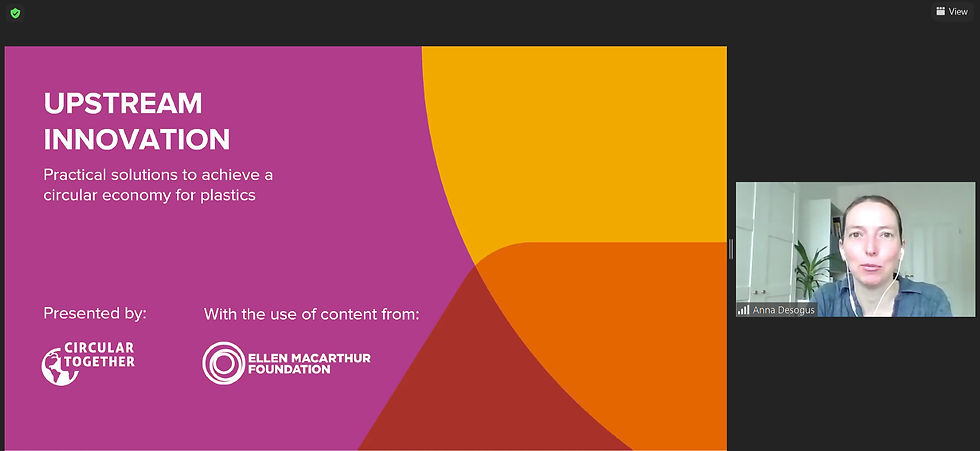Design for circularity: Moving towards upstream
- Laurens Delva
- May 26, 2021
- 3 min read
Hurray! Here is a snapshot of the fantastic third day of our Network Training Event 3 on design for circularity, from me, Nur Gizem Yalcin (or if you prefer the numerical coding, it is ESR 13).
We started the Wednesday morning with a special guest from Brisbane Australia, Dr John Dahlsen. He is a contemporary environmental artist who uses the transformative power of art to bring awareness to the marine plastic problem, for more than 25 years. Plastic objects collected from the Australian coastline by John tell significant stories once they turned into artworks. They first invite the viewers to the beautiful harmony of colours and shapes to feel uplifting. Once the visitors dive into the compositions in detail, multiple questions arise and create moments of reflection on the consequences of the (over)consumption-oriented lifestyles. If you would like to see more of his fascinating artwork and visit stories on the nexus across social comment, aesthetics, and transformation through environmental art, you can visit his webpage here.

In the second part of the morning, my fellow ESR Fernando Lit gave a captivating lecture on the new strategies and business models for a circular plastics economy. He presented the evolutionary process from traditional business models to sustainable and circular business models. Did you know the Business Model Canvas was developed by a PhD student at Lausanne, Switzerland? I didn’t!

A business model refers to the way an organisation creates, delivers, and captures value. While traditional models explicitly focusing on economic value, sustainable business models aim to include environmental and societal values in their propositions. Circular business models, on the other hand, further integrate the principles of circularity through slowing, narrowing, or closing the resource loops. Many of us are familiar with the closing strategies but the other two also brings significant advantages. Slowing loops focuses on designing products that are more durable and long-lasting, while narrowing loops aims to use fewer resources for the same output. A growing number of companies are now encouraging their customers to buy better, not newer. Sounds interesting, right?
Now, let’s take a moment together: what is the is the first thing that comes into your mind when you hear design for circularity? (Or the second, or the third thing?..) If you find yourself trapped into ideas only concerning design for recycling, you are not alone. But be aware, this signals the need to shape your perspective! The third talk of the day challenged us to rethink the new ways of designing out waste in plastic packaging, products, and business models. Anna Desogus, the founder of Circular Together, presented the upstream innovation mindset and facilitated an interactive workshop, both based on this fascinating report by Ellen MacArthur Foundation.

If you came home to find that your apartment was flooding, would you immediately start mopping up the water? Mopping up would not solve the overflowing, first you need to make sure to turn off the taps. With the same principle, upstream innovation focuses on how to prevent waste from being created in the first place rather than working out how to deal with massive amounts of them afterwards. It is looking at the root cause of a problem, rather than the symptoms, to find a solution.
We tried to embrace this thinking in our workshop on upstream innovation for plastic packaging. Brainstorming started by questioning the need for packaging itself and if possible, eliminating it directly. If the packaging is essential, it is then focusing on enabling reuse through redesigning the products or the systems. As a last step, it is to ensure that materials will be able to recycled or composted. There are many possibilities out there, already demonstrated by these impressive case studies. So, let’s keep upstream mindset high on societal and political agendas!

After rounds of fruitful discussions, our third day has ended with a much memorable social event. A local artist from Ghent, Jonas De Rave, played a solo set on the hammered dulcimer, performing the pieces he created during the lockdown period. The evening ended with an online karaoke session, where everyone repurposed objects they have at home as microphones, from water bottles to toothbrushes and brooms, to sing all together! Oh yes, we all unmuted ourselves (imagine that!).
All in all, excellent lectures and inspiring discussions during the day followed by laughter and joy in the evening was truly delightful, already looking forward to our next Network Training Event in Denmark!



Comments